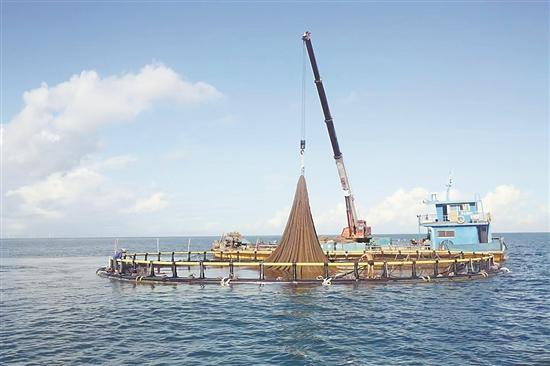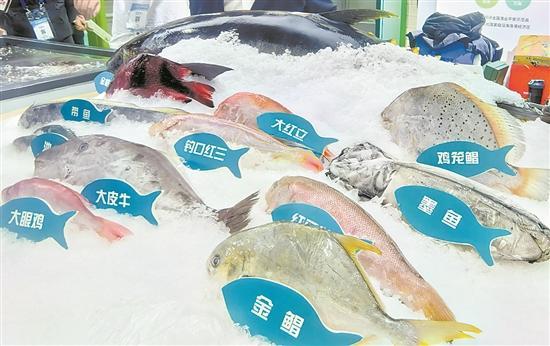
Recently, the "Guangdong Province Modern Marine Ranching Development Master Plan (2024—2035)" was released, marking the first comprehensive plan in China covering the entire marine fisheries industry chain. This signifies that Guangdong's modern marine ranching construction has entered a new phase. Leveraging its abundant marine resources and advantages in scientific and technological innovation, Guangdong is transitioning from a "follower" to a "leader," laying a solid foundation for the construction of modern marine ranches.

Guangdong boasts the longest continental coastline in the country, with over 40% of it utilized for fisheries, and is home to 1,963 islands of various sizes, providing unique conditions for the development of modern marine ranches. In 2023, Guangdong's total marine aquaculture output reached 3.573 million tons, with marine fish, crustaceans, and shellfish farming reaching 904,000 tons, 807,000 tons, and 1.8 million tons respectively, all ranking among the top in the nation. Additionally, Guangdong leads the country in the production of marine fish fry and aquaculture feed, forming a complete modern marine fisheries industry chain.
The Plan outlines clear development goals: by 2027, the total marine aquaculture output of the province will reach 4.4 million tons, and the seafood processing rate will be increased to 35%; by 2030, the output will reach 5 million tons, the processing rate will be increased to 40%, and breakthroughs in the intelligent development of deep-sea farming will be achieved; by 2035, the annual farming output will reach 6.2 million tons, the processing rate will be increased to 45%, and Guangdong will become a global seafood production base and trade hub.

Under the guidance of the Plan, Guangdong is promoting scientific and technological innovation and accelerating the introduction of talent. The modern marine ranching talent development plan includes scarce talent in the "high, precise, top, and shortage" introduction catalog, cultivating and attracting leading talents to promote seed industry innovation and equipment research and development. Corporate innovation has also become a key driving force. The Plan proposes a pilot "subsidy to investment" mechanism, encouraging enterprises to carry out technology research and development and market expansion throughout the entire industry chain, cultivating industry main forces, and accelerating large-scale and industrial development.
The seed industry is the core of the entire industry chain upgrade. The Plan proposes to strengthen the protection of germplasm resources, build a commercial breeding system, and promote seed industry innovation through cooperation between science and enterprises. At the same time, Guangdong is exploring post-subsidy policies to enhance the commercialization capabilities of the seed industry.
In the processing segment, Guangdong focuses on the layout of deep processing parks and pre-cooked food industrial parks, extending the industry chain through characteristic processing. For example, the eastern region of Guangdong mainly features miichthys miiuy and abalone, while the western region focuses on golden pomfret and oysters, creating regional brands to meet high-end consumer demand.
Guangdong is steadily moving towards becoming a strong international marine fisheries province through a series of innovative measures, providing new opportunities for the global seafood market.
Source: Lingnan on the Cloud
广东逐步领跑现代化海洋牧场
近日,《广东省现代化海洋牧场发展总体规划(2024—2035年)》出台,这是全国首个涵盖海洋渔业全产业发展的规划,标志着广东现代化海洋牧场建设步入新阶段。凭借丰富的海洋资源与科技创新优势,广东从“跟跑”逐步迈向“领跑”,为现代化海洋牧场建设奠定坚实基础。
广东拥有全国最长的大陆岸线,渔业利用岸线占比超过四成,还有大小海岛1963个,为发展现代化海洋牧场提供了得天独厚的条件。2023年,广东海水养殖总产量达357.3万吨,其中海水鱼类、甲壳类和贝类养殖分别达90.4万吨、80.7万吨和180万吨,总量均居全国前列。同时,广东的海水鱼苗和水产饲料产量全国领先,形成了完整的现代海洋渔业产业链。
《规划》明确了发展目标:到2027年,全省海水养殖总产量达到440万吨,海产品加工率提升至35%;到2030年,产量达到500万吨,加工率提升至40%,并实现深远海养殖智能化突破;到2035年,年养殖产量达620万吨,加工率提升至45%,成为全球海产品生产基地和贸易枢纽。
在规划指导下,广东正在加快推进科技创新与人才引进。现代化海洋牧场人才发展计划将相关紧缺人才纳入“高精尖缺”引进目录,通过培养和吸引领军人才,推动种业创新与装备研发。企业创新也成为关键动力。《规划》提出试点“补改投”机制,鼓励企业全产业链开展技术研发和市场拓展,培育产业主力军,加速规模化、产业化发展。
种业是全产业链升级的核心。《规划》提出加强种质资源保护,构建商业化育种体系,并通过科企合作促进种业创新。同时,广东还在探索后补助政策,以提升种业商业化能力。
在加工环节,广东重点布局精深加工园区与预制菜产业园区,通过特色加工延伸产业链。例如,粤东地区主打鮸鱼、鲍鱼,粤西地区以金鲳鱼、生蚝为重点,打造区域品牌,满足高端消费需求。
广东正通过一系列创新举措,稳步迈向国际海洋渔业强省,为全球海产品市场提供新机遇。
文|羊城晚报记者 许悦
图|受访者提供
译|赵凡
英文审校|邹晓华
-
2024 Shantou Food Culture Week opens
2024-12-22 23:14:21 -
The fusion of Cantonese culture and international fashion: a fashion show held in the central park of Guangzhou
2024-12-22 23:14:29 -
"Celebrate the Chinese New Year in Guangdong": Guangdong tourism and culture extends a warm invitation to global travelers
2024-12-22 23:14:42 -
One in six Macao families has a JNU member: a driving force in Macao's development
2024-12-21 22:30:31






